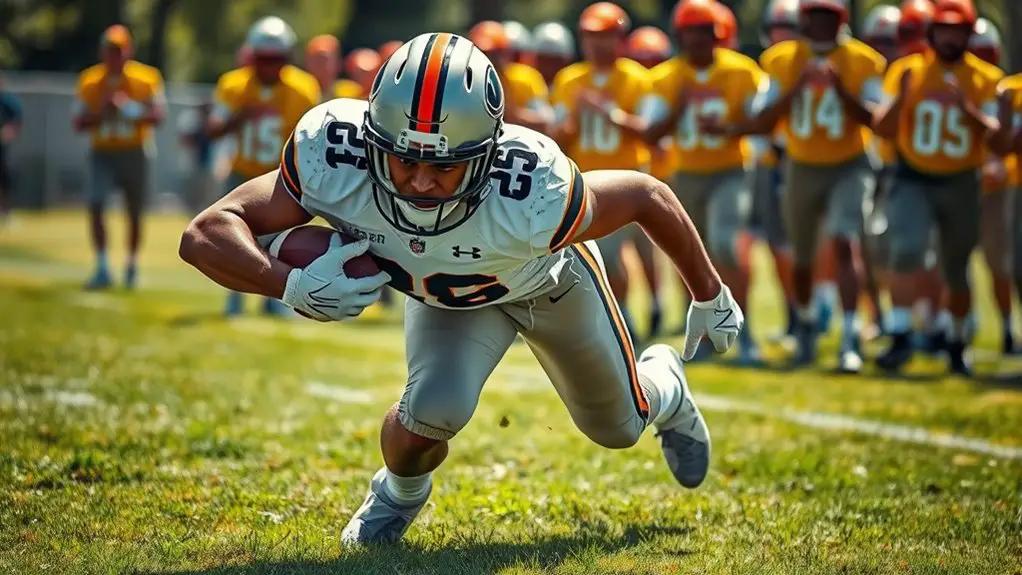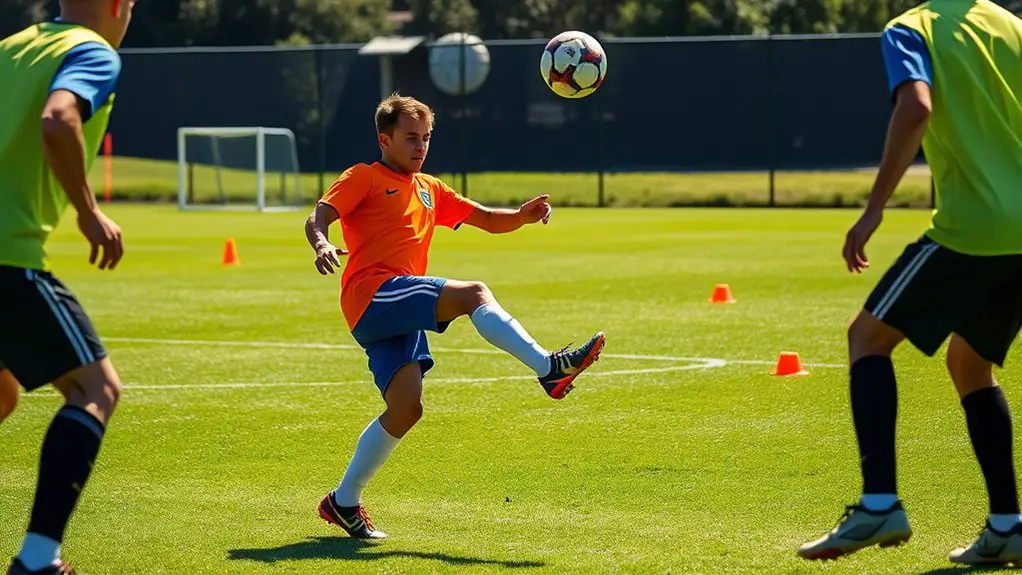As a linebacker, mastering tackling techniques is essential. Start with the wrap technique, where you secure the ball carrier by wrapping your arms around their midsection. Use the shoulder tackle to deliver impactful hits, maintaining proper body position. Be cautious with horse collar tackles, as they carry legal risks. Open field tackles require low hips and smart angles for success. Practicing these techniques will boost your confidence and performance, and there's even more to discover to elevate your game.
Understanding the Fundamentals of Tackling
When you're on the field, understanding the fundamentals of tackling is essential for a linebacker. Mastering effective tackling techniques can be the difference between making a game-changing play and missing the opportunity altogether. Start with the basics: keep your eyes up, lead with your shoulder, and guarantee you're balanced. Practicing tackling drills regularly will sharpen your instincts and improve your form.
Engaging in various drills enhances your ability to read the offense, allowing you to react quickly and decisively. Whether it's a one-on-one situation or a gang tackle, the fundamentals guide your movements and decisions. Remember, it's not just about brute force; it's about technique and timing. The more you incorporate these principles into your practice, the more instinctual they'll become during games. Embrace the freedom that comes with confidence in your tackling skills, and you'll be ready to dominate on the field.
The Importance of Proper Body Positioning
Although it might seem minor, proper body positioning is essential for linebackers to execute effective tackles. When you're aligned correctly, you're not just looking to make a hit; you're setting yourself up for success. Here's why body alignment and stance balance matter:
Proper body positioning is crucial for linebackers, setting the stage for successful tackles and overall performance on the field.
- Stance Balance: A balanced stance allows you to react quickly and maintain control. If you're off-balance, you'll struggle to make that tackle.
- Lower Center of Gravity: Keeping your hips low gives you stability and power. This positioning helps you drive through the tackle rather than just meet the opponent.
- Head Up: Always keep your head up to maintain awareness and control. This way, you can see the play unfold and adjust your approach accordingly.
Additionally, practicing proper warm-ups will prepare your body for the physical demands of tackling, reducing the risk of injuries. Mastering these aspects of body positioning will elevate your tackling game, helping you become a more effective linebacker. So, get out there and practice!
The Wrap Technique: Securing the Ball Carrier
Proper body positioning sets the foundation for effective tackling, and one of the most essential techniques to master is the wrap technique. This approach focuses on securing the ball carrier by wrapping your arms around them, ensuring you maintain control while bringing them down. As you engage, aim for a solid grip around their midsection or thighs. This not only helps you keep your balance but also prevents the ball carrier from escaping easily.
To execute the wrap technique effectively, keep your knees bent and your head up, using your legs for power. Remember, it's about leverage, so engage your core and drive through with your body weight. Timing is vital here; you want to make your move as they approach, closing that gap quickly. Mastering this technique gives you the freedom to tackle with confidence, knowing you can secure the ball carrier and make impactful plays on the field. Additionally, developing mental toughness will enhance your ability to withstand pressure during tackles and improve overall performance.
The Shoulder Tackle: When and How to Use It
When you're using the shoulder tackle, proper body positioning is essential to make an effective hit. You'll need to time your approach perfectly to guarantee you connect with the ball carrier at the right moment. Don't forget to focus on your follow-through techniques to prevent any injuries and maintain control. Additionally, incorporating flexibility training into your routine can help improve your range of motion and reduce the risk of injury during tackles.
Proper Body Positioning
A key aspect of effective tackling is mastering your body positioning, particularly when executing the shoulder tackle. To optimize your approach, focus on the following balance techniques and foot positioning:
- Feet Shoulder-Width Apart: This stance provides a solid base, allowing you to shift your weight efficiently.
- Knees Slightly Bent: Keeping your knees flexed enhances your balance and readiness to move in any direction.
- Head Up, Eyes Forward: This not only helps you see the ball carrier but also keeps your neck safe during the tackle.
Timing Your Approach
Mastering body positioning sets the stage for effectively timing your approach during a tackle. To execute a shoulder tackle, you've got to hone in on your approach angles. As you read the ball carrier's movements, anticipate their next move by adjusting your angle. This isn't just about speed; it's about calculating the right moment to engage. Incorporate timing drills into your practice routine to sharpen your instincts. These drills help you develop a sense of when to close in and deliver that impactful shoulder tackle. Remember, it's all about precision and confidence. Timing your approach effectively can turn a potential tackle into a game-changing play. Embrace the freedom of fluid movement, and let your instincts guide you.
Follow-Through Techniques
Executing a shoulder tackle effectively hinges on your follow-through techniques. Mastering these follow-through mechanics guarantees you maintain tackling momentum and avoid unnecessary penalties. Here's how to nail that follow-through:
- Maintain body position: Keep your head up and shoulders forward to drive through the opponent, guaranteeing you stay balanced.
- Follow with your legs: Use your legs to push through the tackle, generating extra force and stability as you follow through.
- Secure the wrap: Once you've made contact, wrap your arms around the ball carrier to complete the tackle and prevent them from escaping.
The Horse Collar Tackle: Rules and Risks
The horse collar tackle is a maneuver that can lead to serious injuries, making it a controversial technique in football. You need to understand the legal implications surrounding this tackle, as it's often penalized in games. Let's break down what defines a horse collar tackle and the risks involved for both the tackler and the player being tackled.
Definition of Horse Collar
A horse collar tackle is a specific type of defensive maneuver in football that's both effective and risky. This tackle definition refers to grabbing the inside collar of a ball carrier's shoulder pads or jersey, usually from behind, to bring them down. While it can stop a play quickly, it carries some serious risks. Here's what you need to take into account:
- Injury Potential: It can lead to serious injuries for the tackled player, especially to the knees and spine.
- Penalties: Many leagues penalize horse collar tackles, resulting in significant yardage losses.
- Game Impact: Using this technique can alter the flow of the game, affecting momentum and team strategy.
Understanding the horse collar tackle helps you make safer, smarter decisions on the field.
Legal Implications Explained
Understanding the risks associated with horse collar tackles isn't just about player safety; it also involves knowing the legal ramifications within the game. Tackling regulations have become stricter to protect players, and the horse collar tackle is a prime example. If you make this type of tackle, you could face penalties during the game, which can change the momentum noticeably. Furthermore, repeated violations might lead to fines or even suspensions, impacting your career. The legal consequences of these tackles aren't just about the punishment; they also reflect the league's commitment to safety. Embracing these regulations not only helps you stay on the field but also promotes a culture of respect and safety in the sport.
Injury Risks Involved
While tackling is essential to a linebacker's role, the horse collar tackle poses significant injury risks that can affect both the defender and the ball carrier. This technique can lead to serious injuries, which makes injury prevention and tackling safety paramount. Here are three key risks to contemplate:
- Neck Injuries: The sudden pull can cause whiplash or even more severe spinal injuries.
- Knee Injuries: The awkward fall may result in torn ligaments for either player involved.
- Concussions: A hard impact can lead to head injuries that have long-term consequences.
Being aware of these risks allows you to make smarter choices on the field, prioritizing safety while still delivering solid tackles. Always remember that your well-being and that of your opponent matter!
The Open Field Tackle: Techniques for Success
When you find yourself in the open field, mastering the tackle can make the difference between a successful defensive play and a big gain for the offense. To execute effective tackling strategies, focus on your positioning. Keep your hips low and your eyes on the ball carrier's waist; this helps you gauge their movements. As you close in, angle your approach to force the runner toward the sideline or into another defender.
Timing is essential—don't rush in recklessly. Instead, anticipate their next move and be ready to shift your weight accordingly. Use your arms to wrap up securely, ensuring you bring them down safely. Remember, it's about technique, not just brute force. By staying composed and leveraging your agility, you'll enhance your effectiveness in the open field, making those game-changing tackles that define a great linebacker. Incorporating speed training techniques into your practice can further improve your ability to close the gap on ball carriers.
Tackling Drills to Improve Skills and Confidence
Improving your tackling skills requires consistent practice through targeted drills. To build your tackling confidence and face tackling challenges head-on, incorporate these drills into your routine:
- Tackle Bag Drills: Work on your form and technique by hitting tackle bags. Focus on lowering your hips and driving through the bag to simulate real-game situations.
- 1-on-1 Situations: Pair up with a teammate to practice tackling. This gives you a chance to react to a moving target, enhancing your decision-making and timing.
- Shadow Tackle Drills: Without physical contact, practice your footwork and body positioning. This helps you visualize and anticipate tackles, improving your mental preparation.
Safety First: Reducing Injury Risks While Tackling
Tackling is an essential skill for linebackers, but it's crucial to prioritize safety to minimize injury risks. By focusing on injury prevention and employing safe techniques, you can enhance your performance while keeping yourself and others safe on the field. Here are some key points to remember:
| Technique | Description | Benefits |
|---|---|---|
| Proper Stance | Keep feet shoulder-width apart | Lowers center of gravity |
| Shoulder First | Use your shoulder, not your head | Reduces head injuries |
| Wrap and Roll | Wrap the ball carrier and roll them | Controls the tackle safely |
| Eyes Up | Keep your eyes on the target | Improves awareness |
Additionally, practicing proper footwear can significantly enhance your tackling performance and reduce injury risks on the field.
Frequently Asked Questions
How Can I Improve My Tackling Speed and Agility?
To improve your tackling speed and agility, focus on incorporating specific tackling drills into your routine. These drills will help you refine your technique while boosting your overall performance. Pair them with agility exercises like ladder drills or cone sprints to enhance your footwork and reaction time. Remember, it's all about fluidity and confidence. With consistent practice, you'll feel more freedom on the field and tackle with greater efficiency and speed.
What Are Common Tackling Mistakes to Avoid?
When tackling, it's essential to be aware of common mistakes like poor form and overreaching. You don't want to lunge at your opponent, as that can leave you off-balance and vulnerable. Instead, focus on maintaining a strong stance and keeping your body low. By avoiding these pitfalls, you'll improve your effectiveness and stay in control. Embrace your instincts, but remember that technique is key to successful tackling.
How Do I Assess a Ball Carrier's Movements?
To assess a ball carrier's movements, you'll want to focus on their movement patterns. Watch their hips and shoulders; they often give away their next move. Keep an eye on their footwork too, as quick cuts can signal direction changes. Anticipate their actions by studying how they react to defenders. By staying alert and reading these cues, you'll gain an edge, letting you make smarter decisions on the field.
When Should I Use a Diving Tackle?
When you're considering a diving tackle, think about the situation. It's best used when the ball carrier is close, and you need to stop their momentum quickly. The diving tackle benefits include bringing down elusive players, but you should be cautious of its risks, like missing the target or leaving yourself vulnerable to injury. Weigh these factors to decide when it's appropriate to execute that bold move on the field.
What Gear Is Essential for Effective Tackling?
For effective tackling, you need the right gear. Start with solid protective equipment like a helmet and shoulder pads to keep you safe during tackling drills. Don't forget about mouthguards and padded shorts, which can make a big difference in preventing injuries. You want to feel free while playing, so guarantee your gear fits well and doesn't restrict your movement. With the right equipment, you'll tackle with confidence and skill.




